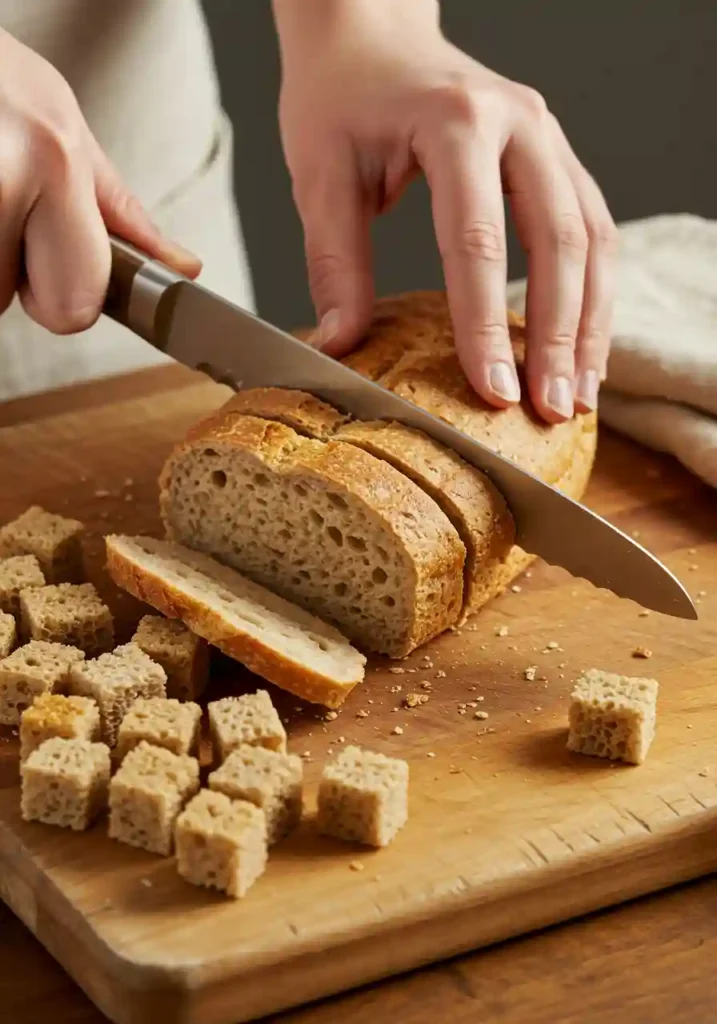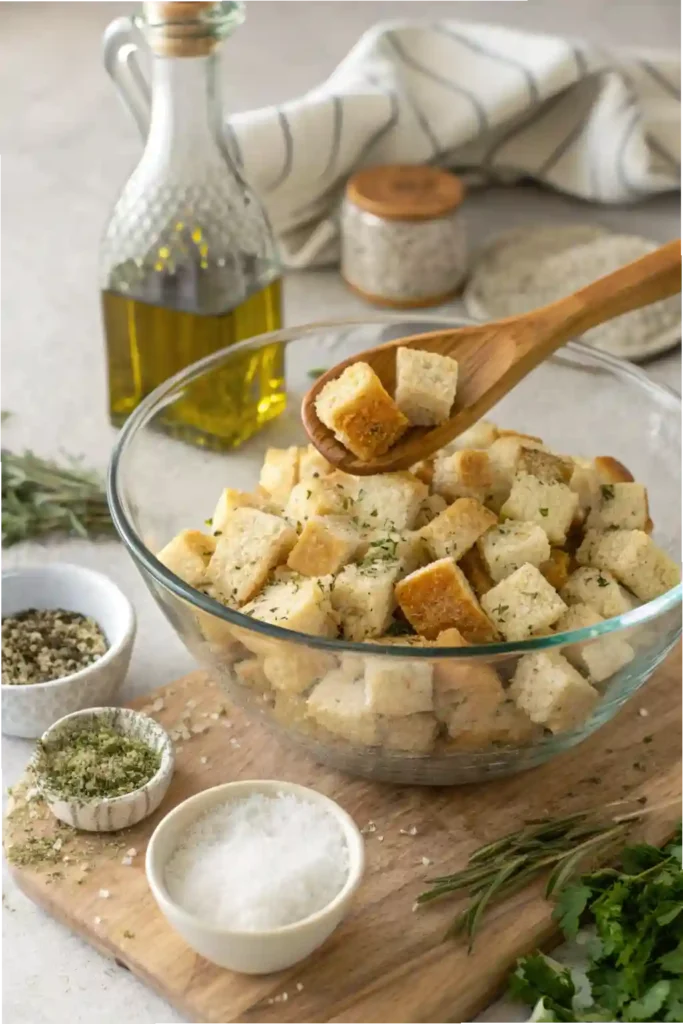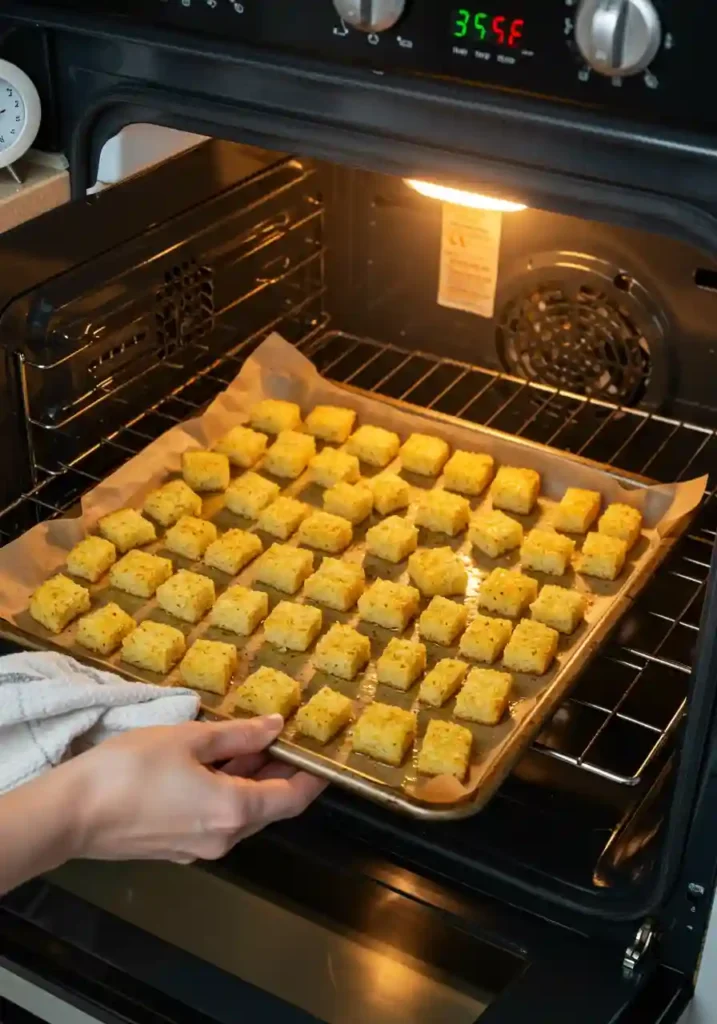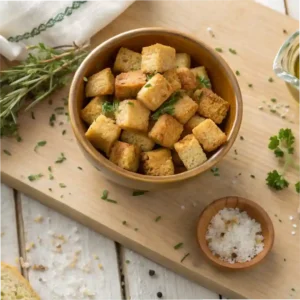Croutons are small cubes of toasted bread often tossed into salads, soups, or even used as a snack topping. Classic croutons typically rely on wheat-based bread, which is off-limits for individuals with celiac disease, a wheat allergy, or non-celiac gluten sensitivity. That can be a real disappointment if you crave the texture and taste of crunchy bread chunks in a Caesar salad or in a steaming bowl of tomato soup.

Nothing elevates a salad or soup like the crunchy bite of homemade croutons. But what if you’re following a gluten-free diet or just want to avoid wheat? Enter these gluten free croutons—lightly seasoned, perfectly toasted bread cubes that bring crunch, flavor, and satisfaction to your favorite dishes. They’re quick to prepare, easy to store, and far healthier than many store-bought options loaded with preservatives.
Table of Contents
Why You’ll Love This Recipe
- Gluten-Free and Guilt-Free
You won’t have to skip croutons just because you can’t eat gluten. Enjoy crunchy toppings on salads, soups, and casseroles without fear of a wheat-based ingredient. - Budget-Friendly
Gluten-free items can be pricey at the store. Making your own croutons at home uses up leftover bread or a loaf that didn’t turn out as hoped, saving money in the process. - Simple Ingredients
You only need gluten-free bread, olive oil (or another fat), and basic seasonings. No fancy equipment or rare ingredients required. - Quick to Prepare
In under 30 minutes—often less—you can have fresh, crisp croutons cooling on your counter, ready to toss into tonight’s dinner. - Versatile Flavors
Season them with garlic powder, Italian herbs, onion powder, or even a sprinkle of cheese. The flavor possibilities are endless. - Texture Heaven
The biggest draw of croutons is the crunchy texture. Our technique ensures crisp edges with a pleasing center—neither burnt nor soggy. - Perfect for Meal Prep
Bake a batch on Sunday, store them in an airtight container, and you’ll have a quick topping for your salads or soups all week.
Ingredients
Here are the essential components for making a standard batch of gluten free croutons—enough for about 4–6 servings, depending on how liberally you sprinkle them:

- Gluten Free Bread (4 slices or about 2 cups cubed)
- Any style works—sandwich bread, sourdough, or artisan. Stale bread is best as it’s less likely to over-soak with oil.
- Any style works—sandwich bread, sourdough, or artisan. Stale bread is best as it’s less likely to over-soak with oil.
- Olive Oil (2–3 tablespoons)
- Adds flavor and helps the cubes crisp up. You could use melted butter or avocado oil if you prefer.
- Adds flavor and helps the cubes crisp up. You could use melted butter or avocado oil if you prefer.
- Salt (¼–½ teaspoon)
- Adjust to your liking. The type of bread you use might already have salt, so season accordingly.
- Adjust to your liking. The type of bread you use might already have salt, so season accordingly.
- Black Pepper (optional, ⅛ teaspoon)
- Provides a little kick. You can skip or add more if you like heat.
- Provides a little kick. You can skip or add more if you like heat.
- Garlic Powder or Onion Powder (½ teaspoon)
- Classic flavor boosters. Some people use dried herbs like rosemary or oregano as well.
- Classic flavor boosters. Some people use dried herbs like rosemary or oregano as well.
- Italian Seasoning (optional, ½ teaspoon)
- A blend of dried basil, oregano, thyme, and rosemary adds an Italian flair. Perfect for Caesar or garden salads.
- A blend of dried basil, oregano, thyme, and rosemary adds an Italian flair. Perfect for Caesar or garden salads.
- Red Pepper Flakes (optional, pinch)
- If you want a spicy twist.
- If you want a spicy twist.
(Note: Some prefer dairy-free, so skip butter if that’s the case. Also, check your bread’s label to ensure it’s truly gluten-free if you’re celiac or highly sensitive.)
Instructions
This method is straightforward and yields croutons that are crispy on the outside, with a pleasant chew on the inside.
Step 1: Preheat and Prep
- Preheat your oven to 375°F (190°C).
- Line a baking sheet with parchment paper or a silicone baking mat.
Step 2: Cube the Bread

- Cut into Cubes: Take your gluten free bread and slice it into ½ to 1-inch cubes. If the bread is fresh and very soft, consider letting it sit out for a few hours to dry slightly.
- Uniform Size: Try to keep cubes roughly the same size to ensure even baking.
Step 3: Season and Oil

- In a Large Bowl: Place all bread cubes.
- Drizzle with Oil: Start with 2 tablespoons of olive oil. You can add more if the cubes look too dry.
- Add Seasonings: Sprinkle on salt, garlic powder, black pepper, and any herbs you enjoy. If you want them spicy, toss in red pepper flakes.
- Toss Gently: Use clean hands or a spatula to coat each cube. This helps lock in flavor and crispiness.
Step 4: Arrange and Bake

- Single Layer: Spread the coated cubes on your prepared baking sheet in a single layer, leaving space so they bake evenly.
- Bake: Slide the tray into your preheated oven. Let them bake for 10 minutes.
- Flip or Stir: After 10 minutes, use a spatula to turn cubes or gently stir them around. This step ensures even browning.
- Continue Baking: Bake another 5–10 minutes or until they reach a golden-brown color and crisp texture.
Step 5: Cool and Store
- Cool on Sheet: Remove from the oven and let them sit on the baking sheet a few minutes. They crisp up further as they cool.
- Taste Test: If they’re not crunchy enough, pop them back for 2–3 more minutes.
- Store: Transfer cooled croutons to an airtight container. They keep for up to a week at room temperature, though the best texture is usually within the first few days.
That’s it! Your homemade gluten free croutons are ready to transform your salads and soups or just serve as a crunchy snack.
Pro Tips and Variations
- Use Slightly Stale Bread
If your bread is fresh and soft, let it sit out overnight or for a few hours. The drier texture soaks up oil and seasoning better, and helps it crisp faster. - Try Different Oils
Olive oil is classic, but avocado oil or melted butter also works. If using butter, watch the oven carefully to prevent burning. - Cheesy Twist
For extra indulgence, sprinkle a little shredded Parmesan or a dairy-free cheese alternative over the cubes before baking. They might brown more quickly, so keep an eye on them. - Go Herb-Heavy
Mix in dried thyme, oregano, or rosemary if you want a robust herb flavor. This is especially good for topping roasted veggie soups or hearty salads. - Make Them Vegan
Many gluten free breads are also vegan, but double-check. Replace butter with oil, and you’re all set. - Avoid Soggy Croutons
If you notice sogginess, you might have used too much oil. Use just enough to lightly coat them. Also, space them out on the baking sheet so they roast rather than steam. - Check Your Sweet Spot
Different ovens can produce varied results. If you like them super crunchy, increase baking time by a few minutes. If you prefer a bit of chew, cut back on the time. - Freezing
If you have leftover bread, cut and freeze the cubes unbaked. Then, thaw slightly and bake as usual. You can also freeze finished croutons, though they might lose some crispness upon thawing. - Use Up Old Bread
If you dislike the texture or flavor of a certain gluten free loaf for sandwiches, turning it into croutons can help you avoid waste.
Serving Suggestions
Wondering how to enjoy your crispy, gluten free croutons? Here are some ideas:
- Classic Caesar Salad
Traditional Caesar typically calls for crunchy croutons. Replace the usual wheat-based ones with your homemade gluten free version, and drizzle a classic or gluten-free Caesar dressing over fresh romaine. - Creamy Soups
Whether it’s broccoli cheese soup, tomato soup, or loaded potato soup, sprinkle a handful of your croutons on top to add a satisfying contrast in texture. - Bowl Toppers
If you’re into grain bowls or hearty vegetable bowls, adding a few croutons can supply that extra crunch you’d normally get from seeds or nuts. - Mixed Snacks
Combine croutons with nuts, seeds, or gluten-free crackers to create a homemade snack mix. Perfect for parties or game nights. - Bruschetta-Style Appetizers
Large gluten free croutons can hold toppings like fresh tomato, basil, and mozzarella (or dairy-free cheese). Perfect as quick bites for gatherings. - Flavor Boost
Keep a small container of these croutons at your desk as a mid-afternoon snack. If you love crunchy textures, they’ll beat store-bought chips loaded with questionable ingredients. - Casserole Crunch
Use crushed croutons as a gluten free casserole topping. This can replace standard bread crumbs in many recipes.
Conclusion
By making gluten free croutons at home, you open the door to crunchy, savory toppings that don’t rely on wheat-based bread. Many store-bought gluten-free croutons can be pricey, bland, or full of additives. But a loaf of your favorite gluten-free bread, a drizzle of oil, some seasoning, and an oven are all you really need to produce a batch of golden-brown bites that perfectly enhance salads, soups, or snack mixes.
This approach is budget-friendly, versatile, and ensures you control every ingredient—great for those with celiac disease, gluten sensitivities, or simply looking for healthier alternatives. Plus, the process takes under half an hour, including baking time. Now that you’re armed with knowledge on pro tips, flavor variations, and serving suggestions, you can get creative and make the perfect crunchy finishing touch for every meal.

Gluten Free Croutons
Ingredients
Gluten Free Bread (4 slices or about 2 cups cubed)
- Any style works—sandwich bread sourdough, or artisan. Stale bread is best as it’s less likely to over-soak with oil.
Olive Oil (2–3 tablespoons)
- Adds flavor and helps the cubes crisp up. You could use melted butter or avocado oil if you prefer.
Salt (¼–½ teaspoon)
- Adjust to your liking. The type of bread you use might already have salt so season accordingly.
Black Pepper (optional, ⅛ teaspoon)
- Provides a little kick. You can skip or add more if you like heat.
Garlic Powder or Onion Powder (½ teaspoon)
- Classic flavor boosters. Some people use dried herbs like rosemary or oregano as well.
Italian Seasoning (optional, ½ teaspoon)
- A blend of dried basil oregano, thyme, and rosemary adds an Italian flair. Perfect for Caesar or garden salads.
Red Pepper Flakes (optional, pinch)
- If you want a spicy twist.
Instructions
Step 1: Preheat and Prep
- Preheat your oven to 375°F (190°C).
- Line a baking sheet with parchment paper or a silicone baking mat.
Step 2: Cube the Bread
- Cut into Cubes: Take your gluten free bread and slice it into ½ to 1-inch cubes. If the bread is fresh and very soft, consider letting it sit out for a few hours to dry slightly.
- Uniform Size: Try to keep cubes roughly the same size to ensure even baking.
Step 3: Season and Oil
- In a Large Bowl: Place all bread cubes.
- Drizzle with Oil: Start with 2 tablespoons of olive oil. You can add more if the cubes look too dry.
- Add Seasonings: Sprinkle on salt, garlic powder, black pepper, and any herbs you enjoy. If you want them spicy, toss in red pepper flakes.
- Toss Gently: Use clean hands or a spatula to coat each cube. This helps lock in flavor and crispiness.
Step 4: Arrange and Bake
- Single Layer: Spread the coated cubes on your prepared baking sheet in a single layer, leaving space so they bake evenly.
- Bake: Slide the tray into your preheated oven. Let them bake for 10 minutes.
- Flip or Stir: After 10 minutes, use a spatula to turn cubes or gently stir them around. This step ensures even browning.
- Continue Baking: Bake another 5–10 minutes or until they reach a golden-brown color and crisp texture.
Step 5: Cool and Store
- Cool on Sheet: Remove from the oven and let them sit on the baking sheet a few minutes. They crisp up further as they cool.
- Taste Test: If they’re not crunchy enough, pop them back for 2–3 more minutes.
- Store: Transfer cooled croutons to an airtight container. They keep for up to a week at room temperature, though the best texture is usually within the first few days.
Notes
Nutrition Information (Per Serving)
- Calories: 85
- Total Fat: 5g
- Saturated Fat: 0.5g
- Cholesterol: 0mg
- Sodium: 120mg
- Total Carbohydrates: 9g
- Dietary Fiber: 1g
- Sugars: 0g
- Protein: 1g
FAQs
Below are answers to frequent questions about croutons, gluten-free diets, and ingredients:
What can I use to replace croutons?
Alternatives include toasted nuts, seeds, or even Parmesan crisps for a crunchy topping. But if you still want something bread-like, homemade gluten free croutons are ideal.
What popular breads are gluten-free?
Brands vary by region, but favorites include Udi’s, Schär, Canyon Bakehouse, and some local artisan brands. Always check labels or ask your baker for a certified gluten-free loaf.
Does rice have gluten?
Plain rice, including white, brown, and wild varieties, does not contain gluten. However, watch for cross-contamination or flavored rice mixes that might include wheat-based additives.
Does cheese have gluten?
Most natural cheeses are gluten-free. Some processed cheeses or cheese spreads may include starches or flavorings with gluten, so always check labels.
What are gluten free salad toppings?
Besides gluten free croutons, you can add toasted nuts, seeds (pumpkin, sunflower), bacon bits (check labels), fresh fruit, or cheese. Avoid crunchy toppings made with wheat flour.
Why are my croutons not crispy?
Possibly too much oil, not enough space on the baking sheet, or not baked long enough. Try spacing them out more or increasing your oven time by a few minutes.
What are the best gluten-free snacks?
Options vary, but popular choices include gluten-free pretzels, rice cakes, vegetable chips, fruit, nuts, or homemade crackers—like your own crunchy croutons used as a snack.
Does garlic gluten-free?
Fresh garlic is naturally gluten-free. Seasonings such as garlic powder are typically gluten-free too, but read labels to confirm there are no hidden wheat additives.


